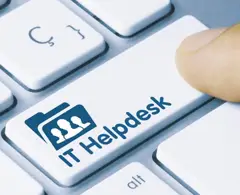
The noun "IT Helpdesk" refers to an internal team within a company's IT department, whose main job is to advise and assist in handling technical issues such as computer errors and system malfunctions. Users can receive support either directly or through email and hotlines.
Additionally, other duties of the IT Helpdesk include:
Behind the glamorous facade, IT Helpdesk also faces several accompanying difficulties, including:

Problem solving: Ability to systematically analyze problems, understand root causes and provide timely solutions.
Communication: Skill to interact clearly and effectively with users from diverse backgrounds over call, email, in-person.
Attention to detail: Ensuring accurate understanding of technical issues being reported and documenting all steps meticulously.
Patience: Ability to calmly handle stressful situations during troubleshooting and emergency cases.
Multi-tasking: Switching efficiently between multiple simultaneous tasks, interruptions without loss of focus.
Leadership: Guiding less experienced teammates, assigning workloads, tracking progress.
Foreign language: Helps assist multi-lingual users more smoothly and access global knowledge base.
Customer service: Polite, helpful, empathetic approach to satisfy users and build trust and credibility.
Time management: Plan and structure activities optimally to meet priorities and deadlines.
Lifelong learning: Keeping skills updated through self-study and professional development courses.

IT Helpdesk Team Leader
Server Administrator
Application Administrator
Security Expert
Database Administrator
IT Manager
To find job opportunities, just access the website and choose the appropriate JD at Aniday.com
Attend short-term training courses on helpdesk basics, operating systems, networking from reputed training centers. These provide fundamentals.
Pursue a 2-year associate degree in Information Technology or Computer Science from colleges/universities.
Earn a 4-year bachelor's degree in IT-related fields like Computer/Network Engineering which offers in-depth learning.
Certifications like CompTIA A+, Network+, Microsoft certified, ITIL can add credentials to the profile.
Learn through online resources - blogs, videos, tutorials to gain practical knowledge on troubleshooting.
Build a home lab to practice on hardware and software installations, configurations.
Seek internship opportunities at corporate helpdesk teams to get industry exposure.
Start with entry-level roles like desktop support technician to gain experience hands-on.
Continually upgrade hard and soft skills through ongoing training and self-study.
Network actively in local user groups and conferences to enhance employability.